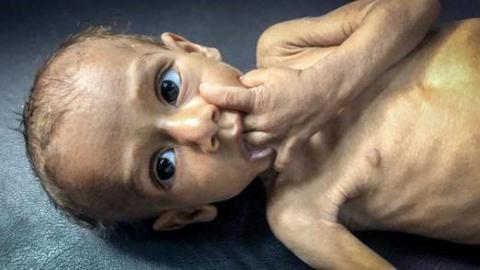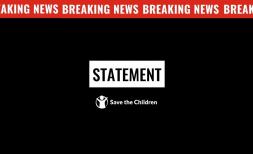Extreme hunger could kill 600,000 children in war zones this year

Extreme hunger could kill 600,000 children in war zones this year
- Hunger on the rise in world’s most brutal war zones
- 2 in 3 infants with life-threatening malnutrition set to go untreated this year
- Alarming shortfalls in funding for conflict zones; spike in obstructions to delivery of humanitarian aid
- Content & case studies available here
More than half a million children in conflict zones could die from extreme hunger before the end of the year, new research by Save the Children shows.
The charity estimates 4,500,000 children under the age of five will need treatment for life-threatening malnutrition this year in the most dangerous conflict zones for children, an increase of nearly 20% since 2016. [1][2]
But at current rates, two in three of these severely malnourished children are set to miss out on vital treatment this year, with 590,000 expected to die as a result. [3][4]
That’s an average of 1,600 children under the age of five dying from extreme hunger every day, or one child every minute.
Save the Children’s new analysis comes as humanitarian agencies grapple with chronic funding shortfalls to many UN emergency appeals for conflict zones, and as warring parties acting in defiance of international humanitarian law increasingly prevent supplies from reaching children in need of help. [5][6]
Global hunger is on the rise after declining for more than two decades, with the UN citing conflict as the main reason for that reversal. [7]
Severe Acute Malnutrition, or SAM, is the most extreme and dangerous form of undernutrition. Symptoms include jutting ribs and loose skin, with visible wasting of body tissue; or swelling in the ankles, feet and belly as blood vessels leak fluid under the skin.
Severely malnourished children also have substantially reduced immune systems and are far more likely to contract and die of diseases like pneumonia, cholera and malaria than healthy children. Even where children survive, the effects of malnutrition can be life-long and affect physical and mental development.
Helle Thorning-Schmidt, CEO of Save the Children International, said:
“In 2018 no child should be dying from hunger. But the number of hungry people on our planet has started to rise again. This is shameful. Hunger is not inevitable.
“Many of these children are in warzones. Time after time we are seeing starvation used as a weapon of war when deliveries of food are obstructed by the warring parties in places like Yemen, Syria and South Sudan.
“We must stop this dangerous trend. All warring parties must abide by their obligations under international law to allow humanitarian access. We also need to see an increase in funding from the international community to save more children’s lives.”
The charity’s mortality estimate includes 300,000 children in the war-torn Democratic Republic of Congo (DRC), where nutrition programmes run by aid organisations and the UN have less than 10 percent of the funding they need.
Some 35,000 malnourished children could also die in Yemen, where obstructions to deliveries of food and medicine by all sides – including a coalition of Arab states backed and armed by Britain – have pushed the country to the brink of famine.
But in the three states of northeast Nigeria hardest hit by conflict, Borno, Adamawa and Yobe, cases of untreated severe acute malnutrition are now estimated to fall to about 12,000 after two years of sustained action. While this is still troubling – about 2,000 of these children could be expected to die without treatment – it represents a substantial drop on previous years. In 2016, there were an estimated 300,000 untreated cases and 60,000 deaths in the three states.
Save the Children is appealing for urgent donations to help aid workers and local health partners reach more children through treatment and feeding programmes in war zones across the world. It takes 150 sachets of enriched peanut paste – at a cost of just £30 – to save a malnourished child’s life and help them recover.
The aid agency is calling on governments around the world to protect children in conflict – including from hunger – and to hold those responsible for blocking food and medicine to account.
CASE STUDY: DEMOCRATIC REPUBLIC OF CONGO
13-month-old Kasadi was close to death when she was brought into a clinic supported by Save the Children in the Democratic Republic of Congo (DRC).
Her mother Kapigna had fled into the bush after an attack on her village, leaving the family’s food and belongings behind (full story here). And after weeks in the bush, Kasadi began to starve.
When she arrived at the clinic, Kasadi weighed just four kilograms, less than half the weight of a healthy baby her age. She was also suffering from pneumonia and diarrhoea.
But after a course of antibiotics and three days of nutrition treatment her weight increased to 5.2 kilograms. Save the Children has given Kapigna a two-month supply of enriched peanut paste to help Kasadi put on more weight and fully recover.
“In our hospital, the three diseases that affect children the most are measles, pneumonia, and meningitis. Malnutrition is usually combined with one of the three illnesses,” says Didier Musanya Kabaz, the baby’s nurse. “When the child is malnourished, it’s very easy for the child to get ill. The functions of the organs are heavily affected, increasing the susceptibility to diseases.”

CASE STUDY: YEMEN
In the past year Save the Children and its local partners have treated 65,000 children for malnutrition across Yemen.
But in June the Saudi-led coalition launched an assault on the country’s main port of Hodeidah, threatening to sever a lifeline for vital supplies of food, fuel and aid. After more than three years of war, a quarter of children under the age of five living in the city were malnourished even before the assault began.
One-year-old Nusair* was lucky to survive (see here for full case study). He was suffering from a deadly combination of severe malnutrition and diarrhoeal disease when he reached a health facility supported by Save the Children. His mother Suad* had braved landmines, checkpoints and airstrikes to get him there.
Nusair faced death a second time during his treatment when an airstrike hit near the hospital he was attending. Dozens died in the blast – but he and his mother survived.
“My dream is simple – the war must stop so we can live in peace,” his mother says. “The casualties of this war are ordinary people, civilians.”
Estimated Severe Acute Malnutrition (SAM) caseload and mortality for children under the age of 5 in conflict zones
Country | Estimated SAM caseload 2018 | Estimated untreated SAM caseload 2018 | Estimated mortality 2018 (Range) |
|
|
|
|
Democratic Republic of Congo (DRC) | 1,900,000 | 1,660,530 | 327,457 (227,825 - 427,088) |
Sudan | 693,942 | 518,328 | 105,635 (74,536 - 136,735) |
Afghanistan | 571,000 | 356,344 | 72,035 (50,636 - 93,433) |
Yemen | 394,153 | 175,119 | 36,197 (25,690 - 46,704) |
Somalia | 231,829 | 115,914* | 23,693 (16,321 – 31,065) |
South Sudan | 269,140 | 94,976 | 18,800 (13,097 - 24,504) |
Syria | 18,831 | 11,071 | 2,372 (1,707 – 3,037) |
(NE) Nigeria | 439,523 | 11,932 | 2,326 (1,610 - 3,043) |
Central African Republic (CAR) | 37,281 | 9,437 | 1,800 (1,233 - 2,367) |
Iraq | Data Unavailable | Data Unavailable | Data Unavailable |
Total | 4,555,699 | 2,953,651 | 590,315 (412,655 - 767,976) |
Sources: UN OCHA (Humanitarian Needs Overview), Nutrition Cluster, Save the Children research. *Save the Children operational estimates based on FSNAU July update.
NOTES TO EDITORS:
[1] Save the Children previously identified the ten most dangerous conflicts for children – based on conflict intensity, the number of children living near to conflict, and ‘grave violations’ against children recorded by the UN in 2016.
They are: Syria, Afghanistan, Somalia, Yemen, Nigeria, South Sudan, Iraq, the Democratic Republic of Congo (DRC), Sudan, and the Central African Republic (CAR). See the War on Children reportfor more information.
[2] Based on an analysis of UN Humanitarian Needs Overview (HNO) malnutrition estimates for 2018, 4,555,699 children under the age of five will need treatment for Severe Acute Malnutrition this year in nine of the ten most dangerous conflict zones for children, up 18% from 3,859,738 cases in 2016.
Data was unavailable for Iraq. The number of children in need of treatment across all conflict-affected countries globally could be expected to be higher. (By comparison, the total under-five population of Great Britain was 3,837,740 in mid-2017, according to the Office for National Statistics.)
[3] If rates of coverage in the first half of this year remain unchanged, Save the Children estimates nutrition programmes will be unable to reach 2,953,651 children with Severe Acute Malnutrition in the ten most dangerous conflict zones this year, 65% of the total estimated caseload.
[4] The estimate of 590,000 deaths represents the mid-point of an estimate range for mortality in cases of untreated Severe Acute Malnutrition, based on longitudinal studies and an average Middle Upper Arm Circumference (MUAC) of severely malnourished children in each conflict zone.
The lowest level is 412,655 deaths, assuming a MUAC of 110mm. That rises to 767,976 when MUAC is assumed to be 106mm.
[5] As of July 31, the average level of humanitarian funding for nutrition programmes in the ten most dangerous conflict zones was 33.6%, according to Save the Children’s analysis of data from the UN’s Financial Tracking Service. The nutrition cluster response in the Democratic Republic of Congo (DRC) was just 8.6% funded.
[6] Save the Children’s analysis of annual UN Children and Armed Conflict (CAAC) reports found 1,460 verified cases of ‘grave violations’ of children’s rights due to the denial of humanitarian access in 2017, up from 1,014 cases in 2016. It also represents a twenty-fold increase on the 64 verified incidents in 2010. Violations include obstructions to the delivery of aid for children, and attacks on aid workers assisting children.
[7] Ten out of the 13 major food crises in 2016 were conflict-driven. See: Food and Agriculture Organization of the United Nations and World Food Programme, Monitoring Food Security in Countries with Conflict Situations, issue No. 3 (January 2018).
For more information or to arrange interviews please contact Salma Dewji on +44 (0) 7926 162 103. Out of hours contact media@savethechildren.org.uk / +44(0)7831 650 409.
About Save the Children
Save the Children stand side by side with children in the toughest places to be a child. We do whatever it takes to make sure they survive, get protection when they’re in danger, and have the chance to learn. Together, we fight for children every single day. Because every child should be able to make their mark on their world, and help to build a better future.
**DONATE to Save the Children here**




